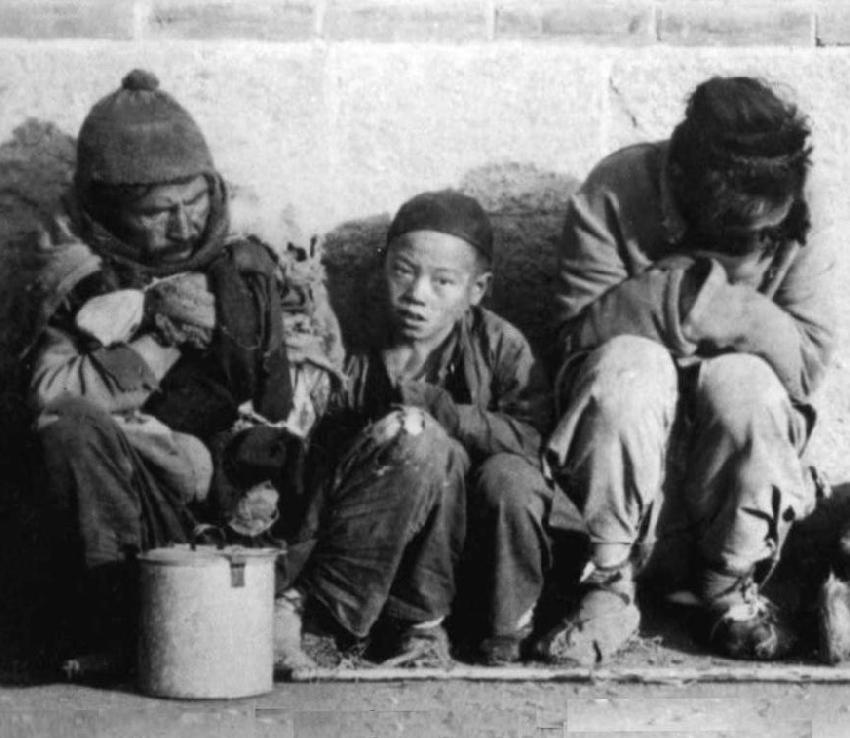
Chinese Civil War: The Kuomintang and the Communists Break (1927)

Figure 1.--The 20th century was one of the most tumultuous in Chinese history. The country was in a state of almost continuos turmoil, war or civil war. As a result of the fighting, the Chinese people suffered terribly. People were not only caught up in the fighting, but people were keft homeless and hungary. Interespersed within the turmoil were fanmines and food shortages resulting from both the turmoil as well as natural disasters. Tragically the most deadly famine came after the victory of the Revolution and resulted from Mao's policies. Unlike Stalin, however, Mao was not trying to cause a famine.
|
|
The Communist Party (CPC) had been an important part of the Kuomintang (KMT). The KMT was a revolutionsry party, although an exclusiveky Marxist party like the Communists. They began to compete with the Kuomintang and with their increasing following of workers in major cities began to be seen as a threat by right-wing KMT elements. Chiang whose father was a wealthy landlord increasingly became associated with the right wing of the KMT. Mao Tse-tung emerged as the primary Communist leader. He wrote about Protracted War and tactics against the Japanese. As the Communists grew in power, Chiang after dealing with the war lords, decided to destroy the Communists (1927). Chiang was strongly influenced by a German mercenary Gen. von Falkenhausen who he appointed his army's chief of staff. Chiang in a surprise action banned the Communist Party and condemned everyone with ties to the Party with death. Chiang launched a horendous campaign using tactics on his own people not unlike methods the Japanese would use. KMT operations in Shanghai were called the Shanghhai Masacre (April 12). Historianns estimate that Chiang's forces killed an estimasted 1 million men, women, and children. Chiang forces persued horendous operations. Suspected Comminunists were subjected to terrible tortures. Whole families and even villages were wiped out if suspected of Communist sympathies. Chiang's brutality in the anti-Comminist campaign would later impair Chiang's ability to unite China to fight the Japanese. Chiang brutal suppression campaign and nearly succeeded in destroying Communist forces. Communist leader Chen Duxiu and Soviet advisors had conseled cooperation with the KMT. They were totally discredited. The CPC launched worker uprisings in major cities: Changsha, Shantou, Nanchang and Guangzhou. This was the beginning of the Civil War. The CPC in Nanchang launched a major uprising (August 1927). The CPC soldiers under Zhu De were defeated. Some were able to escaped the KMT forces by retreating to the mountains of western Jiangxi. Mao Zedong led the Autumn Harvest Uprising in Hunan province (September 1927). His small, poorly armed peasant army was defeated. He also retreated to Jiangxi. There he began building what would eventually become the People's Liberation Army. The CPC Central Committee was eventually forced to flee Shanghai (1933). Mao set up peasant-based soviets in Jiangxi and Hunan provinces. This essentially completed the CPC from an urban workers movement to a pesantt movement in the countryside.
HBC

Related Chronolgy Pages in the Boys' Historical Web Site
[The 1880s]
[The 1890s]
[The 1900s]
[The 1910s]
[The 1920s]
[The 1930s]
[The 1940s]
[The 1950s]
[The 1960s]
[The 1970s]
[The 1980s]
[The 1990s]
[The 2000s]
Related Style Pages in the Boys' Historical Web Site
[Long pants suits]
[Knicker suits]
[Short pants suits]
[Socks]
[Eton suits]
[Mao jacket]
[Jacket and trousers]
[Blazer]
[School sandals]
[School smocks]
[Sailor suits]
[Pinafores]
[Long stockings]
Navigate the Boys' Historical Clothing Web Page
[Return to the Main Pacific War page]
[Return to the Main Chinese Civil War page]
[Return to the Main Chinese 20th century page]
[Introduction]
[Activities]
[Biographies]
[Chronology]
[Clothing styles]
[Countries]
[Bibliographies]
[Contributions]
[FAQs]
[Glossaries]
[Images]
[Links]
[Registration]
[Tools]
[Boys' Clothing Home]
Created: 2:10 AM 7/5/2011
Last updated: 2:10 AM 7/5/2011



